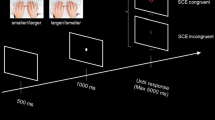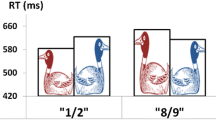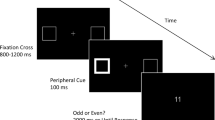Abstract
This study investigated the relationships between numerical and spatial representations by means of a bisection task, exploring the view that the core representation of number meaning is spatially organized as a mental number line. In Experiment nos. 1 (bisection of digit strings) and 2 (bisection of flanked lines) spatial biases towards the larger digit were found to be related only to processing of relative magnitude. Experiment nos. 3 (bisection of an unfilled space) and 4 (bisection of flanked lines/unfilled spaces) aimed at disclosing perceptual, attentional, and numerical constraints on the bias induced by the position of the larger digit. This effect is interpreted in terms of a cognitive illusion of length, whereby a spatial bias compensates for the numerical disparity. This seems to operate in a categorical fashion (“small/large”), and to be congruent with the assumption that relatively large numbers are associated with the right side of a mental representational space.








Similar content being viewed by others
References
Bachtold D, Baumuller M, Brugger P (1998) Stimulus-response compatibility in representational space. Neuropsychologia 36:731–735
Berch DB, Foley EJ, Hill RJ, Ryan PM (1999) Extracting parity and magnitude from Arabic numerals: developmental changes in number processing and mental representation. J Exp Child Psychol 74:286–308
Bradshaw JL, Bradshaw JA, Nathan G, Nettleton NC, Wilson LE (1986) Leftwards error in bisecting the gap between two points: stimulus quality and hand effects. Neuropsychologia 24:849–855
Butterworth B (1999) The mathematical brain. MacMillan, London
Calabria M, Rossetti Y (2005) Interference between number processing and line bisection: a methodology. Neuropsychologia 43:779–783
Campbell JID, Fugelsang J (2001) Strategy choice for arithmetic verification: effects of numerical surface form. Cognition 80: B21–B30
Chokron S (2002) On the origin of free-viewing perceptual asymmetries. Cortex 38: 109–112
Daini R, Angelelli P, Antonucci G, Cappa SF, Vallar G (2001) Illusions of length in spatial unilateral neglect. Cortex 37:710–714
Dehaene S (1992) Varieties of numerical abilities. Cognition 44:1–42
Dehaene S (2003) The neural basis of the Weber–Fechner law: a logarithmic mental number line. Trends Cogn Sci 7:145–147
Dehaene S, Akhavein R (1995) Attention, automaticity, and levels of representation in number processing. J Exp Psychol Learn Mem Cogn 21:314–326
Dehaene S, Mehler J (1992) Cross-linguistic regularities in the frequency of number words. Cognition 43:1–29
Dehaene S, Bossini S, Giraux P (1993) The mental representation of parity and number magnitude. J Exp Psychol Gen 122:371–396
Dehaene S, Piazza M, Pinel P, Cohen L (2003) Three parietal circuits of number processing. Cogn Neuropsychol 20:487–506
Eviatar Z (2000) Culture and brain organization. Brain Cogn 42:50–52
Fias W (2001) Two routes for the processing of verbal numbers: evidence from the SNARC effect. Psychol Res 65:250–259
Fias W, Brysbaert M, Geypens F, d’Ydewalle G (1996) The importance of magnitude information in numerical processing: evidence from the SNARC effect. Math Cogn 2:95–110
Fischer MH (1996) Bisection performance indicates spatial word representation. Cogn Brain Res 4:163–170
Fischer MH (2000) Word centre is misperceived. Perception 29:337–354
Fischer MH (2001) Number processing induces spatial performance biases. Neurology 57:822–826
Gallistel CR, Gelman R (1992) Preverbal and verbal counting and computation. Cognition 1–2:43–74
Gallistel CR, Gelman R (2000) Non-verbal numerical cognition: from reals to integers. Trends Cogn Sci 4:59–65
Galton F (1880) Visualised numerals. Nature 21:252–256
Gevers W, Reynvoet B, Fias W (2003) The mental representation of ordinal sequences is spatially organized. Cognition 87:B87–B95
Gevers W, Reynvoet B, Fias W (2004) The mental representation of ordinal sequences is spatially organized: evidence from days of the week. Cortex 40:171–172
Ito Y, Hatta T (2004) Spatial structure of quantitative representation of numbers: evidence from the SNARC effect. Mem Cogn 32:662–673
Jewell G, McCourt ME (2000) Pseudoneglect: a review and meta-analysis of performance factors in line bisection tasks. Neuropsychologia 38:93–110
Moyer RS, Landauer TK (1967) The time required for judgements of numerical inequality. Nature 215:1519–1520
Mozer MC, Halligan PW, Marshall JC (1997) The end of the line for a brain-damaged model of unilateral neglect. J Cogn Neurosci 9:171–190
Nöel MP, Fias W, Brysbaert M (1997) About the influence of the presentation format on arithmetical-fact retrieval processes. Cognition 63:335–374
Orr CA, Nicholls MER (2005) The nature and contribution of space- and object-based attentional biases to free-viewing perceptual asymmetries. Exp Brain Res 162:384–393
Restle F (1970) Speed of adding and comparing numbers. J Exp Psychol 83:274–278
Seron X, Pesenti M, Noel MP, Deloche G, Cornet JA (1992) Images of numbers, or when 98 is upper left and 6 sky blue. Cognition 44:159–196
Siegler RS, Opfer JE (2003) The development of numerical estimation: evidence for multiple representations of numerical quantity. Psychol Sci 14:237–243
Vallar G, Daini R, Antonucci G (2000) Processing of illusion of length in spatial hemineglect: a study of line bisection. Neuropsychologia 38:1087–1097
Vuilleumier P, Ortigue S, Brugger P (2004) The number space and neglect. Cortex 40:399–410
Wynn K (1998) Psychological foundations of numbers: numerical competence in human infants. Trends Cogn Sci 2:296–303
Zorzi M, Priftis K, Umiltà C (2002) Brain damage: neglect disrupts the mental number line. Nature 417:138–139
Acknowledgements
This work was supported in part by a PRIN grant to G.V. M.D. d. H. is supported by a QUA_SI fellowship, from the University of Milano-Bicocca.
Author information
Authors and Affiliations
Corresponding author
Rights and permissions
About this article
Cite this article
Dolores de Hevia, M., Girelli, L. & Vallar, G. Numbers and space: a cognitive illusion?. Exp Brain Res 168, 254–264 (2006). https://doi.org/10.1007/s00221-005-0084-0
Received:
Accepted:
Published:
Issue Date:
DOI: https://doi.org/10.1007/s00221-005-0084-0




